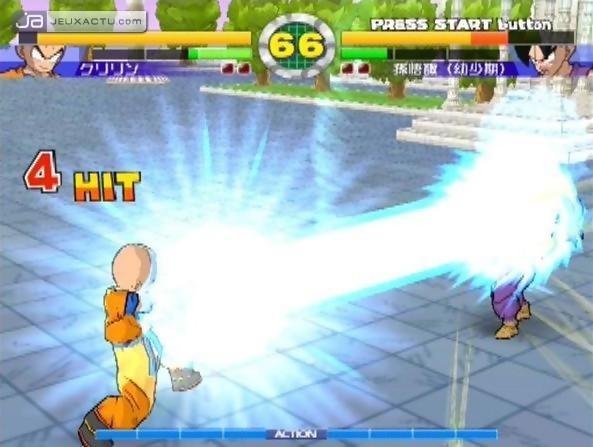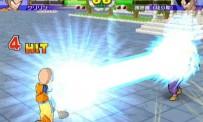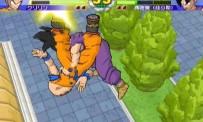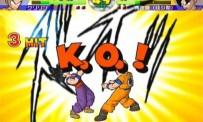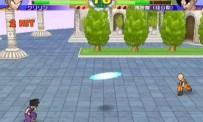 Mixing the universe of Dragon Ball Z with the mythical gameplay of Street Fighter II, the idea is not new. Those who closely follow Son Goku's video game performances will remember Dragon Ball Z 2: Super Battle, a fighting game released in Arcade in 1995 and which already took up the principle of old school fighting game style clashes. Without being too bad, the experience was not conclusive either, so that no other publisher dared to try the adventure again. It will therefore have been necessary to wait eleven good years for the Crafts & Meister studio to decide to take the plunge. Composed of former Capcom members who worked on Street Fighter II, the young Japanese company thus set itself up as the ideal candidate to make the link between DBZ and Street Fighter II. First released on arcade machine, Super DBZ (Chou Dragon Ball Z for its Japanese title) is finally adapted on PS2. The adaptation, although perfect, may pose some problems for Sony's monolith.
Mixing the universe of Dragon Ball Z with the mythical gameplay of Street Fighter II, the idea is not new. Those who closely follow Son Goku's video game performances will remember Dragon Ball Z 2: Super Battle, a fighting game released in Arcade in 1995 and which already took up the principle of old school fighting game style clashes. Without being too bad, the experience was not conclusive either, so that no other publisher dared to try the adventure again. It will therefore have been necessary to wait eleven good years for the Crafts & Meister studio to decide to take the plunge. Composed of former Capcom members who worked on Street Fighter II, the young Japanese company thus set itself up as the ideal candidate to make the link between DBZ and Street Fighter II. First released on arcade machine, Super DBZ (Chou Dragon Ball Z for its Japanese title) is finally adapted on PS2. The adaptation, although perfect, may pose some problems for Sony's monolith.
Chou ryû ken
 Since the respective releases of Dragon Ball Z: Budokai 3 in 2004 and Dragon Ball Z: Budokai Tenkaichi in 2005, fans of Toriyama's work have become demanding. It must be said that the Dimps and Spike studios have set the bar damn high. The unexpected arrival of a game of the caliber of Super DBZ on PS2 can therefore be a task. First of all, from a technical point of view, the title of Crafts & Meister does not measure up to the two games mentioned above. In addition to a very particular character design that will not please everyone, the cel-shading turns out to be mostly coarse with a range of colors that appears very bland on the screen. It is enough to see the different breaking waves of each of the characters to understand how the developers of Crafts & Meister have savagely botched their work. The Kaméhamé and other Final Flash indeed take on the shapes of diamonds or trapeziums which cannot prevent us from smiling slyly. We are witnessing the same spectacle of consternation concerning the animation of the fighters, which is very choppy, even mechanical. It's quite unfortunate because the modeling of the characters remains generally quite successful, even if we don't reach the level of Dragon Ball Z: Budokai Tenkaichi.
Since the respective releases of Dragon Ball Z: Budokai 3 in 2004 and Dragon Ball Z: Budokai Tenkaichi in 2005, fans of Toriyama's work have become demanding. It must be said that the Dimps and Spike studios have set the bar damn high. The unexpected arrival of a game of the caliber of Super DBZ on PS2 can therefore be a task. First of all, from a technical point of view, the title of Crafts & Meister does not measure up to the two games mentioned above. In addition to a very particular character design that will not please everyone, the cel-shading turns out to be mostly coarse with a range of colors that appears very bland on the screen. It is enough to see the different breaking waves of each of the characters to understand how the developers of Crafts & Meister have savagely botched their work. The Kaméhamé and other Final Flash indeed take on the shapes of diamonds or trapeziums which cannot prevent us from smiling slyly. We are witnessing the same spectacle of consternation concerning the animation of the fighters, which is very choppy, even mechanical. It's quite unfortunate because the modeling of the characters remains generally quite successful, even if we don't reach the level of Dragon Ball Z: Budokai Tenkaichi.
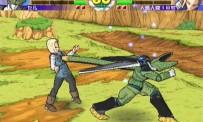 The transition is all found since Super DBZ is also difficult to see regarding the casting. Eighteen characters and not one more. Admit that it is insufficient for a fighting game worthy of the name, especially if we compare it to the sixty fighters who appear in Dragon Ball Z: Budokai Tenkaichi (the reference game when it comes to DBZ) and the 100 announced in its sequel. When we talk about the 18 protagonists of the game, we also include the 5 hidden characters Majin Vegeta, Mecha Frieza, Kaioh Gohan, Videl and Satan Petit Coeur. A meager pittance completed by a not really judicious choice since two of them are duplicates even if in absolute terms, the big attacks are not the same. Still, the characters offered in Super DBZ are far from the best and the sayajins transformations come down to the first step. But it seems that it is on the side of the gameplay, of the combat system that the game becomes interesting since different from other games stamped DBZ. True ?
The transition is all found since Super DBZ is also difficult to see regarding the casting. Eighteen characters and not one more. Admit that it is insufficient for a fighting game worthy of the name, especially if we compare it to the sixty fighters who appear in Dragon Ball Z: Budokai Tenkaichi (the reference game when it comes to DBZ) and the 100 announced in its sequel. When we talk about the 18 protagonists of the game, we also include the 5 hidden characters Majin Vegeta, Mecha Frieza, Kaioh Gohan, Videl and Satan Petit Coeur. A meager pittance completed by a not really judicious choice since two of them are duplicates even if in absolute terms, the big attacks are not the same. Still, the characters offered in Super DBZ are far from the best and the sayajins transformations come down to the first step. But it seems that it is on the side of the gameplay, of the combat system that the game becomes interesting since different from other games stamped DBZ. True ?
Dragon Fighter 2006
 Unlike episodes of the series Budokai ou Tenkaichi, Super Dragon Ball Z's combat system is closer to a classic 2D fighting game in that attacks and other special moves are triggered using manipulations on the directional pad. Quarter-circles forwards, semi-circles backwards, dragon punch, we find all the old school sensations that are irremediably reminiscent of Street Fighter or to Kof. We therefore find a power bar graduated in three levels and which makes it possible to release large attacks such as Kaméhamé, Masenko or other Big Bang Attacks, the equivalent of a fury in a Kof. Unfortunately, we should not expect breaking waves blinding the screen like those we saw in Dragon Ball Z: Budokai 3. Certainly, after a few hours of play, it will be possible to unlock the dragon finishes for more impressive attacks, but we still wonder why they are not accessible from the outset. Here the spectacular aspect has been reduced to its bare minimum. Even the proposed combos pale in comparison, so much so that the amateur of a good fight will find it difficult to find his account.
Unlike episodes of the series Budokai ou Tenkaichi, Super Dragon Ball Z's combat system is closer to a classic 2D fighting game in that attacks and other special moves are triggered using manipulations on the directional pad. Quarter-circles forwards, semi-circles backwards, dragon punch, we find all the old school sensations that are irremediably reminiscent of Street Fighter or to Kof. We therefore find a power bar graduated in three levels and which makes it possible to release large attacks such as Kaméhamé, Masenko or other Big Bang Attacks, the equivalent of a fury in a Kof. Unfortunately, we should not expect breaking waves blinding the screen like those we saw in Dragon Ball Z: Budokai 3. Certainly, after a few hours of play, it will be possible to unlock the dragon finishes for more impressive attacks, but we still wonder why they are not accessible from the outset. Here the spectacular aspect has been reduced to its bare minimum. Even the proposed combos pale in comparison, so much so that the amateur of a good fight will find it difficult to find his account.
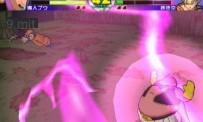 But in order to stick to the universe created by Akira Toriyama, the developers therefore thought of integrating elements inherent in any series flanked by the name DBZ. We can thus fly away to dodge the aggressive attacks of certain characters who are adept at shooting repeatedly. Lack of luck, this trick valid in any other title DBZ turns out to be detrimental to Super DBZ. The fights - already not very exciting (the fault of a limited range of moves and off-topic staging) - then lose intensity. The environments, although destructible, do not add anything to the title either since they are too small to take full advantage of them and too vast for a software whose gameplay is supposed to be closer to a 2D fighting game. We could then have turned to the different game modes to alleviate his frustration, but nothing helped. No "Story" mode or real challenges to unlock a plethora of bonuses, you just have to be satisfied with a "Survivor", "Versus" and "Character Edition" mode, the only good surprise in the game since it is possible to customize the different heroes of the series. It's obvious, Super DBZ navigates between two waters. On the one hand, the title tries to stand out with its gameplay supposedly taken from 2D fighting games, but also gives the impression of wanting to copy the series of Budokai et Tenkaichi, without having the ardor. We therefore wonder if the public will respond even at a small price of 30 €.
But in order to stick to the universe created by Akira Toriyama, the developers therefore thought of integrating elements inherent in any series flanked by the name DBZ. We can thus fly away to dodge the aggressive attacks of certain characters who are adept at shooting repeatedly. Lack of luck, this trick valid in any other title DBZ turns out to be detrimental to Super DBZ. The fights - already not very exciting (the fault of a limited range of moves and off-topic staging) - then lose intensity. The environments, although destructible, do not add anything to the title either since they are too small to take full advantage of them and too vast for a software whose gameplay is supposed to be closer to a 2D fighting game. We could then have turned to the different game modes to alleviate his frustration, but nothing helped. No "Story" mode or real challenges to unlock a plethora of bonuses, you just have to be satisfied with a "Survivor", "Versus" and "Character Edition" mode, the only good surprise in the game since it is possible to customize the different heroes of the series. It's obvious, Super DBZ navigates between two waters. On the one hand, the title tries to stand out with its gameplay supposedly taken from 2D fighting games, but also gives the impression of wanting to copy the series of Budokai et Tenkaichi, without having the ardor. We therefore wonder if the public will respond even at a small price of 30 €.
A big thank you to the Tokyo Eyes store who was kind enough to lend us the game.
